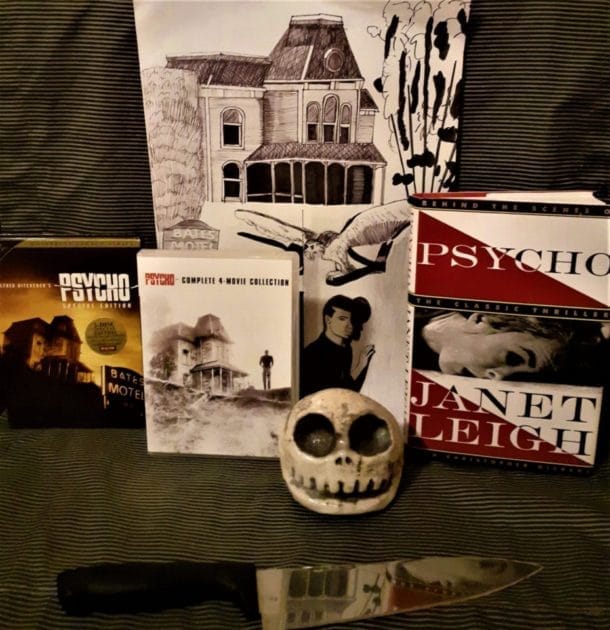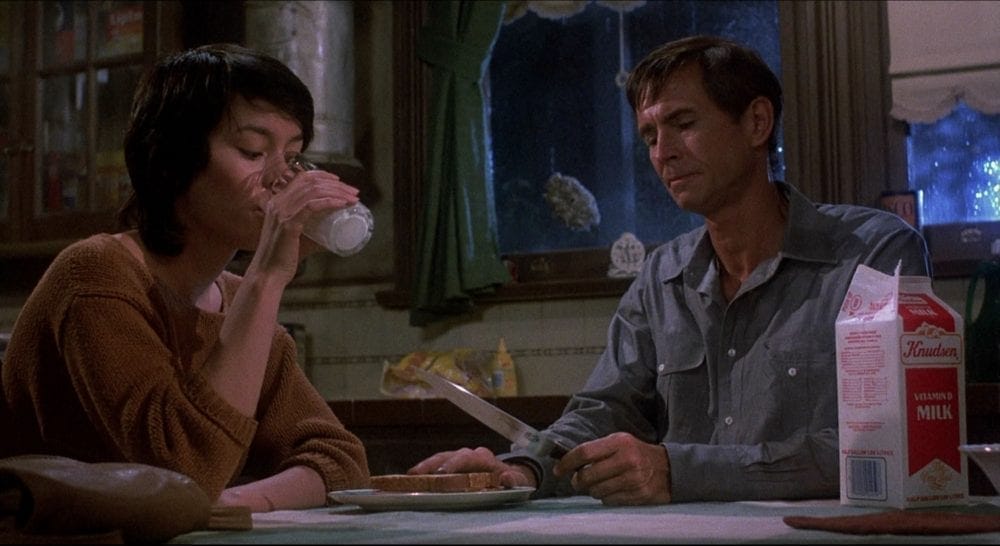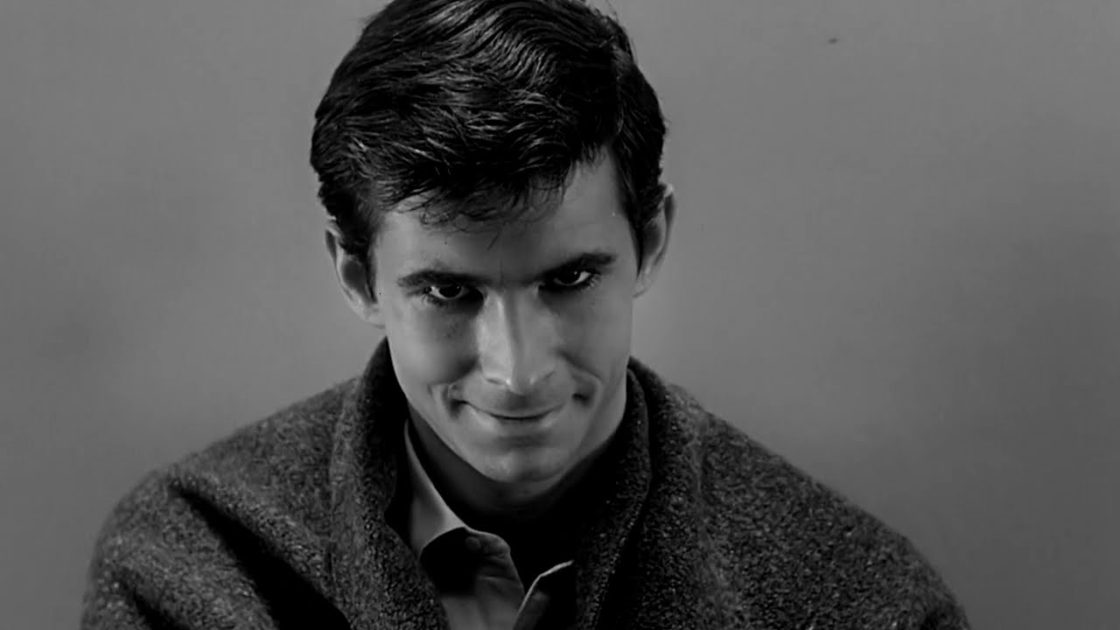A Boy’s Best Friend: A Breakdown of Psycho Movies I-IV
Have you ever wanted to know everything about all the Psycho movies? Well, you’ve come to the right place. Psycho 1, 2, 3 & 4 reviewed.

A guest post from Laura Smith, who has dropped in with a breakdown of all the Psycho movies. Everything you ever wanted to know and more about all four of these classic horror movies. From the best Psycho quotes to audience reactions. This is a Psycho movie full breakdown and will give you all the information you ever need.
Matricide: The Most Unbearable Crime of All
It was on a hot summer night in June of 2000 when I first sat down to watch Alfred Hitchcock’s Psycho. It was airing as a special event on TCM, and, like most teens, I had developed a newfound love of horror. So, I had some catching up to do, and Psycho felt like a crucial notch to add to my horror movie belt. As a result, it’s become one of my favorite movies of all time.
It would take over 20 years for the first of three Psycho movie sequels to this classic film to be made. Coincidentally, it would take 20 years for me to gain access to these sequels. They never aired on TV during the Halloween season. I never saw them on the shelf at any of my local video stores. I never even saw them pop up on a streaming service.
To me, that hinted at the probability that they were terrible. Too terrible to be shown again. The kind that can ruin the original. The kind you turn off because you don’t care how it ends. Or the kind of sequels that have nothing to do with the original. They just utilize the title to draw in a few horror movie buffs.
Psycho Score
So, when I recently found a Psycho movie DVD Four Pack of all four Psycho movies at my local Walmart on Black Friday, I made an impulse buy. I also had little expectation as to the quality of the films, rather than a way to finally slake my curiosity about how they continue the Psycho story. I was floored to find that all of the films are not only watchable but at times completely satisfying, loyal to the original, and appropriately modernized for their time. Here is my Psycho movie full breakdown of Psycho I-Psycho IV: The Beginning.
Alfred Hitchcock’s Psycho – Act 1
I could rattle off trivia and analysis of 1960s Psycho all day. Hitchcock’s shooting techniques and the crowd-drawing gimmick of not being let into the theater after the film began give the audience the full effect of the big reveal at the end. But the first act of Psycho is a slow burn that is painstakingly tricky to pull off, especially nowadays.
And I know my 14-year-old self found that pacing confusing. I had to keep reminding myself that this wasn’t the modern-day teen slasher that I was used to. This was the pioneer of slasher movies.
Still, no kills in the first 30 minutes? Just some woman who steals $40,000 from her employer so that she can run away from Arizona to California to be with her boyfriend. And why can’t they be together? Because he’s divorced and…poor? My understanding of the culture at that time was entirely ignorant. But as interesting as it was to dive into this world, which captured a time 25 years before my birth, I started to get antsy.
These days, I relish the first act of this movie for all of the setups, statements, and suspense that it entails. I love catching new details, watching Marion fumble around as the world’s most conspicuous thief, and recording the slew of bad decisions that it takes to lead her to her fate.
The Halfway Twist in Psycho
Has another movie ever been able to pull off a twist in the middle of a movie as well as Psycho? Watching with my family for the first time, including my parents who had seen the movie before, they started to get excited when Marion pulls off the road in the pouring rain and caught the Bates Motel sign through the windshield. There was also an air of nervousness as a tall, shy, but friendly motel owner, Norman Bates (Anthony Perkins), ran into the frame to check in our heroine.
So this is where it’s all going to go down, I thought. Marion has just entered into her final girl role, just like Janet Leigh’s real-life daughter, Jamie Lee Curtis, when she walks across the street to check on her friends in 1978’s Halloween. What I didn’t realize is that the iconic final girl had yet to be introduced in cinema in 1960.
After an awkward but captivating talk with our newly introduced character, Marion steps into the iconic shower. Wait..what? No, she’s not the one who dies in the shower because she’s our hero.
And then, the curtain is pulled back, the strings begin to shriek, and the crisp sounds of the knife plunging over and over again into her skin make your heart race. It’s every bit as raw and (horrifically) thrilling as you’d imagined as swirls of black blood race down the shower drain.
Genre Switch
The film kicks into high gear from there, even though what follows is a lengthy scene of dutiful son Norman cleaning up what was his mother’s mess. After all, we saw her silhouette as she cut poor Marion like a cantaloupe. But this is what Hitchcock does best, putting the audience in the fly-on-the-wall role, playing Blue’s Clues with Perkins to help him with his task, reminding him to look through the drawers and not forget the newspaper on the nightstand, the one filled with nearly $40,000 in cash whose relevance disappears as Marion’s car sinks below the surface of the swamp.
From there, the film becomes a detective story, weaving through clues on the shoulders of Sam and Marion’s sister, Lila, whom I refer to as “Diet Marion,” as they step in to investigate Marion’s disappearance once Mother takes care of Arbogast. Now, this is more like it. But not really.
The Twist
There’s no mystery for the audience. We see who’s committing these murders. It’s Mother. Not only do I not realize how wrong I am, but neither do my parents. As Norman carries her down to the fruit cellar while she protests all the way, I make a wisecrack about how he should just throw her down the stairs or something, and they point out to me, “You know it’s him, don’t you?”
“What do you mean?” I ask.
“He’s mother.”
So close to the big reveal, the ending has been inadvertently spoiled for me by my overeager parents, who weren’t aware that I didn’t know that the woman being carried through the bedroom and down the stairs to the fruit cellar was a corpse and that the person speaking was Norman. I was floored. As floored as those reaction videos of parents showing their kids the original Star Wars trilogy for the first time and discovering that Darth Vader is Luke Skywalker’s father.
Then, Lila turns that rocking chair around, and there are Mrs. Bates’ hollow eyes staring at you. I realized this was another iconic moment I’d seen parodied before and didn’t realize what it was from (thanks, Tiny Toon Adventures). What follows is a psychological breakdown from a smug but knowledgeable psychiatrist, Dr. Richmond, who explains everything to my naïve, young mind.
Room for More
Needless to say, the final shot of Norman’s chilling grin at the end of the movie leaves you wanting more. Still, my initial reaction to the movie was “slow but a cool ending.” Then I realized that it was sticking with me. I was going over the events and filling in the blanks.
Any chance I got, I watched it again and again, acclimating myself to the pacing, the genius acting, and the eerie shots, my favorite being the scene of Norman standing at the swamp and turning towards the sound of Sam Loomis calling his name from the motel as the camera pans toward his face and the mysterious score plays.
It’s not just a great horror movie, it’s a great movie. Because of that, it would be almost impossible to live up to the original, especially in an era when sequels sacrificed quality to make a quick buck as cheaply as possible. So, it was shocking to discover how well Psycho II avoids the sophomore slump and stands alone as a solid and entertaining sequel to one of the greatest films ever made.

Psycho II
When it comes to making a horror movie sequel, there are many more opportunities to get things wrong. Pair that with a 20-year gap between films, a leading man who has aged considerably since we last left him, and numerous changes to the genre since Psycho trailblazed its way into horror movie notoriety, and you have a recipe for disaster.
The Psycho II movie takes its predecessor very seriously. It also understands that it’s no longer the year 1960. It’s now 1983. Bernard Hermann’s strings have been replaced with a more ghostly score. The Psycho 2 score is a mix between 80’s classics Poltergeist and Pet Sematary. The black and white film has been updated to color, and the kills are gorier and less psychological.
It also assumes that its audience is all caught up in the events of the previous movie and after replaying the infamous shower sequence, I guess just to do it, it opens with Norman being released from the hospital with a clean bill of health, and Lila Crane, now Lila Loomis, is not okay with it. Nor should the audience be. In what way could a man with Norman’s condition possibly be cured of his psychosis? But then you shut up because you want to see where this is going. Delightfully, you realize that he’s going home.
The Bates House and Motel in the Psycho Movies and Their Easter Eggs
The smartest thing Psycho II and the rest of the sequels did was feature the iconic house on the hill overlooking the long stretch of motel out in the middle of nowhere. Norman is set up with a job at the diner just down the street. Presumably, the same diner that he had suggested to Marion, who was reluctant to go out in the pouring rain on the night of her murder.
It’s one of the dozens of Easter eggs in Psycho II that allude to the original film. These Easter eggs include a dinner of sandwiches and milk, repeated lines from the original Psycho movie, and even a character named Mary Samuels. Mary Samuels is Marion’s alias that she writes down in Norman’s book when he checks into the hotel.
Perkins plays Norman as a haunted man rather than a disturbed one. His fear of relapsing back into his old ways is crippling at times, yet he is just as good-natured and friendly as he was before. Somehow, the film pulls off the audience’s doubts about whether or not he’s back on the rampage, putting the question back into our minds as to who is committing the murders that start to take place in and around the motel.
Acclimating to the ’80s
Being made in the ’80s, the filmmakers knew that they had to update the kills and the pacing for a modern audience. So, we get a Friday the 13th vibe in the voyeuristic camera work and an increased gore factor to the bloody murders. Not surprising.
What is surprising, though, is how seriously Psycho 2 takes itself and how many bullseyes it hits. It keeps the original film in mind constantly, without hanging on to it to help carry it from start to finish.
This causes you to ignore, or even embrace, the weaker elements of the plot. Things such as the townspeople’s ability to allow a clinically insane mass murderer to not only live on his own but also work in the food service industry. This is even though he poisoned his first two victims, one of them being the person who would turn into his alter ego, his mother.
There’s also the somewhat confusing plot twist in Psycho II and the audience’s ability to endure Mary, played by Meg Tilly, who can barely act and who, for obvious reasons, has no chemistry with Perkins. But she does get to play an integral part in probably the best line of the Psycho II movie when Norman tells Mary she smells good.
“What do I smell like?” she urges while she embraces him in a comforting hug.
“You smell like… like the toasted cheese sandwiches.”
Psycho movie quote
He goes on to give a logical explanation of this description, but the unexpectedness of the line is hysterical.
I came out of Psycho II with a sense of relief. I try not to let bad sequels ruin a good movie, but it’s even better when you can welcome a sequel into the canon rather than disregard it.

🔪 More Chilling Reviews Like Psycho
Obsessed with serial killers, disturbed minds, and Norman Bates-style suspense? Check out these slasher film titles:
Psycho III
Psycho III picks up one month after the events of Psycho II, though it was released three years later in 1986, coincidentally the year I was born. Perkins directed this sequel, probably thinking that if this is the only part he can get, he may as well have total creative control over it.
In this story, Norman takes in an ex-nun, Maureen, who is still reeling over her involvement in the death of a fellow nun due to her suicidal tendencies, which are never fully explored. She had controlling parents, something that Norman can relate to. But from what I can tell, her story doesn’t even come close to the abuse that he endured as a child, which led to his murderous split personality.
Also introduced is an aspiring musician, Duke, who gets a job at the Bates Motel after pulling his beat-up car up to the lobby door and needing to make a few bucks to get his brakes fixed and break into the music business. Oh, and he also nearly rapes Maureen after giving her a ride the day she runs away from the convent. So, she’s not too happy to see him when Norman brings her home, despite the haunting fact that she reminds him of Marion Crane.
A Drop in Quality For the Psycho Movies
Psycho 3 is about Norman finally standing up to his mother and not letting her control his life anymore. It’s a lot grittier of a film than the previous two Psycho movies. It delves deep into the 80s slasher genre. However, Psycho 3 does continue to call back to the original film. This film repeats more iconic lines and even has one victim murdered on a toilet, showing just how far they’ve come since the Hitchcock days, when just showing a toilet flush on camera was considered obscene.
There are no likable characters. Even Perkins seems to be phoning it this time around. Maybe he was too distracted with his directing duties. Or maybe his style of acting just doesn’t translate as well among so many younger castmates. I found myself getting bored towards the middle, but things get back on track towards the end in the big climax, which doesn’t bode well for Norman or Mother. The twist at the end of Psycho III isn’t as big as in the previous two films. It is a satisfying callback to the ending of the first Psycho movie and even corrects some of the confusion from the convoluted but ultimately superior Psycho II.
Psycho IV – Psycho IV The Beginning
Four years later, Psycho IV: The Beginning aired as a TV movie in 1990. Somehow, it made it into my DVD pack, for which I’m grateful, as it brings the events full circle, as its subtitle suggests.
Perkins returns one last time to play Norman Bates, looking worn out by the character and happy to let Henry Thomas do the heavy lifting as the younger version of himself. The story is told mainly in flashbacks chronicling Norman’s earliest kills, concluding with his mother’s and her boyfriend’s.
In Psycho 4, we see Mrs. Bates alive and well. She is a much younger woman than the gray-haired, floral-printed-clad corpse barking orders from her sunken-in bed.
Is she crazy?
Yes.
Is Mrs. Bates the monster that we’ve all suspected her to be? Not really, when you’ve seen the crazy cinematic mothers who have come since. She frequently threatens castration and constantly hurls verbal abuse. There’s also the domineering ordering around which he both relishes and abhors, as we come to see in his later years. Yet, she’s more eccentric than destructive. I just can’t buy that what we see her do is enough to turn her sensitive son into a literal psychopath.
Family Man
Even more puzzling is the fact that Norman has been released from the mental institution yet again (though it’s never confirmed whether this film ties into Psycho II and III at all). And on top of that, he’s married and expecting a baby.
His wife, Connie, seems like a nice, normal lady. Her history with Norman has never been addressed until the fan service Psycho movie ending. The two had a brief exchange over the phone about Norman’s birthday cake. But is she insane to take up with him and then purposely get pregnant despite his reservations? I have to side with Norman on this one.
Blending the Past and Present & The Psycho Song
The score is back!
Psycho IV’s best move was to bring back the original film’s score. The Psycho song sets a nostalgic tone, especially in the flashback sequences. But 30 years have passed since the original film, and Norman is no longer living in his old house (good idea).
He spends most of the film on the phone, anonymously telling his story to radio show host Fran Ambrose, whose theme of that night’s broadcast is matricide. But as she and her guest, Dr. Richmond, start to piece his story together, they realize they are talking to Norman Bates. And Norman talks about wanting to kill again.
Even though he is literally (no pun intended) phoning it in and his delivery is a bit outdated, Perkins still plays a superior Norman Bates to the otherwise talented Henry Thomas. In Bates Motel, Thomas holds up well against Freddie Highmore. But Thomas doesn’t play the Norman Bates that we see in the original Psycho movie, the shy but friendly and accommodating Norman who just wants some company. He’s standoffish and cold as if his mother is breathing down his neck while girls, and even older women, mindlessly throw themselves at him.
There’s also no interesting or three-dimensional woman in the film. They’re either ditzy, passive, or crazy. But you just have to laugh and shrug it off because, like the original, it was made on the cusp of a new decade. When the change was imminent but had not yet arrived.
Without giving too much away, the film ends with the Bates’ house being set on fire, clearing away the past. Does that mean that the “psycho” is gone? He’s certainly come a long way since his black-and-white debut as one of the most iconic villains in movie history.
Pulling It Off
Overall, the Psycho movie franchise is a rare, successful one. As long as you don’t ask too much of it. It gives fans everything they want: the continuity of the Bates house and motel, the ongoing torture of Norman wrestling with his past and unsuccessfully keeping it out of his present, and good old-fashioned slasher movie kills, beginning with the first.
The franchise gets more right than wrong. And that’s because there’s such a fascinating character implanted in the eye of that storm. It just goes to show what you can do with a charismatic man with a truckload of baggage who tends to “go a little mad sometimes.”


